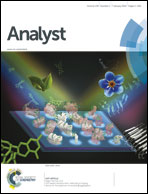Ratiometric sensing of fluoride and acetate anions based on a BODIPY-azaindole platform and its application to living cell imaging†
Abstract
A new BODIPY-azaindole based fluorescent sensor 1 was designed and synthesized as a new colorimetric and ratiometric fluorescent chemosensor for fluoride. The binding and sensing abilities of sensor 1 towards various anions were studied by absorption, emission and 1H NMR titration spectroscopies. The spectral responses of 1 to fluoride in acetonitrile–water were studied: an approximately 69 nm red shift in absorption and ratiometric fluorescent response was observed. The striking light yellow to deep brown color change in ambient light and green to blue emission color change are thought to be due to the deprotonation of the indole moiety of the azaindole fluorophore. From the changes in the absorption, fluorescence, and 1H NMR titration spectra, proton-transfer mechanisms were deduced. Density function theory and time-dependent density function theory calculations were conducted to rationalize the optical response of the sensor. Results were supported by confocal fluorescence imaging and MTT assay of live cells.


 Please wait while we load your content...
Please wait while we load your content...